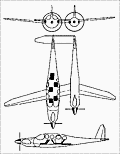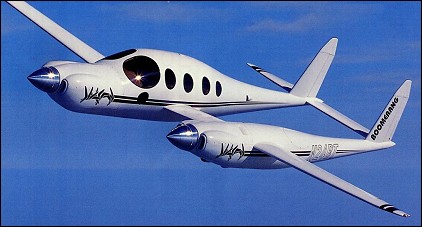|
| The first prototype flew in 1996.
 | A three-view drawing (750 x 959) |
| MODEL | "Boomerang" |
| CREW | 1 |
| PASSENGERS | 4 |
| ENGINE | 1 x Lycoming TIO-360-A1B, 150kW |
| WEIGHTS |
| Take-off weight | 1900 kg | 4189 lb |
| Empty weight | 1070 kg | 2359 lb |
| DIMENSIONS |
| Wingspan | 11.2 m | 37 ft 9 in |
| Length | 9.32 m | 31 ft 7 in |
| PERFORMANCE |
| Max. speed | 525 km/h | 326 mph |
| Cruise speed | 390-490 km/h | 242 - 304 mph |
| Range w/max.fuel | 3900 km | 2423 miles |
| Norman Roy Rhinehart, e-mail, 30.04.2015 01:08 Am a 76yr. old scratch builder. At WWW.Luft46 you see the B&V 218 & the 193 fighter bombers I've built & flown. Others-Brequet 790 Seaplane & drones. Would like to built a RC plane of Boomerang 202. Already built /flown John Pond's Pond racer! Please advise. Roy reply | | PDR, e-mail, 04.09.2011 20:18 Nick said "The whole point of this aircraft (apart from a private transport for Burt) is to demonstrate a twin engined layout where trim changes are minimal and safe if either engine fails. Don't ask me how this is acheived I couldn't begin to guess."
You're essentially right. This design came from an observation that most light twins are lethal if they get an engine failure at low speed because they have a minimum asymetric control speed (Vmca) which is well above the airspeed they could sustain on one engine. Burt set out to design an aeroplane whose Vmca was below its stall speed at all weights and in all configurations, with neither side being worse than the other. He more or less achieved this, and has demonstrated the fact in practical trials.
The logical progression from conventional twin to this layout was the subject of a talk Burt gave at Oshkosh in the early 90s, and a full write up of the lecture appeared in the british magazine "Pilot" a few months later. Once you've read the article you find it's not so much a question of why the Boomerang is such a strange shape, but rather one of why twins are ever designed any other shape...
:-)
PDR reply | | erika, e-mail, 09.08.2011 21:08 Not to put too fine a point on it, but Scaled didn't have anything to do with this airplane, it's Burt's personal design and build. So it should be the Rutan Model 202 Boomerang. reply | | LR, e-mail, 08.03.2010 09:32 Actually, from the three view there are some clues. If you look at a three view of a Beech Baron vs. this aircraft, you'll see that the engines are much closer to centerline on this one. Then you'll see that the fins are further back, and there's one behind each engine so that the slipstream from the working prop adds more control power. I suspect the asymmetry of the layout also works with the engine's direction to help, but that's a bit harder to figure out.
origin-images.rcuniverse.com /forum /upfiles /23497 /Zx71506.jpg reply | |
| | Nick, e-mail, 23.07.2007 09:15 Its got two engines,
A Lycoming TIO-360C1A6D, 210 hp (157 kW) is mounted in the fuselage nose
The whole point of this aircraft (apart from a private transport for Burt) is to demonstrate a twin engined layout where trim changes are minimal and safe if either engine fails. Don't ask me how this is acheived I couldn't begin to guess reply |
|
Do you have any comments?
|
| 
All the World's Rotorcraft |











